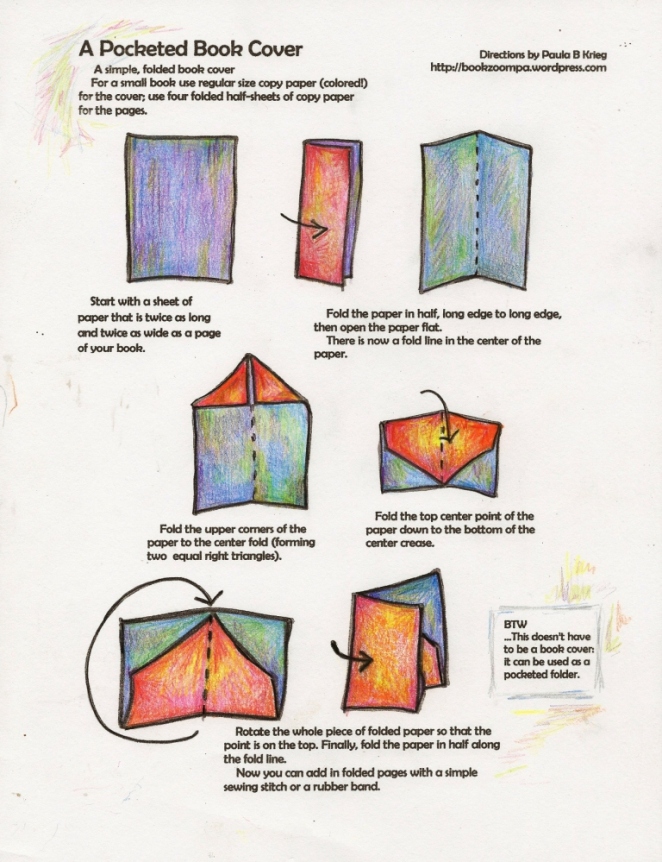This is the second year I have done this journal project with fifth graders in Saratoga Springs. I wrote about it last year, but in less detail than I plan to write about it today.
This workshop day was requested by the school’s reading specialist, who had done a similar project on her own with a few students. She was impressed by the students’ reaction to their journals, and thus requested that I come for a day and make these books with the whole grade level, about 70 students.

We used paper from large wallpaper sample books. These books are 17″ tall, and about 12″ wide, though the width of the pages is bound tightly with industrial size staples. I cut the papers out of the books, so the final size is 17″ x 11 1/4;, though standard 17″ x 11″ paper would work well too. Wallpaper books are fun to use because each student’s book is visually unique.
The students folded the covers according to the directions above, with one exception. Before the last step of closing the cover, I asked them to snip off the tip of the triangle, about the width of a pencil.

Students then folded 5 sheets of standard sized paper, 8 1/2″ x 11″, however, to give the pages an antique-like look, we used Ivory faux parchment paper, made by Southworth. The four inside pages were run through the copy machine to copy on the lines pictured above. The outside page is unlined because, well, I like the look of unlined paper when the book is first opened.

Last year, to attach the pages to the cover, we had used a lovely cord called Rattail, from a beading shop, which turned out to be too smooth and slippery: the students’ knots kept coming undone. Yarn, twine or cotton cord could be other choices. Just nothing too stiff, too thick, or too smooth. This year we used 30 inch lengths of black and silver craft cord to attach the pages to the spine of the book cover, doing a no-needle method of sewing, illustrated in the direction sheet below.

This pretty much finished up the project. I like a book that feels more substantial, so, for a finishing touch, I handed each student two sheets of stiff oaktag type papers to slip into the front and back inside pockets.

I recommended that the students choose for themselves whether or not they wanted to put a dab of glue on the stiff paper so that it would, or would not, permanently affixed to the pocket. Also, they made their own decision as to whether or not they wanted to add a bit of glue to the edge of the pocket, thus closing off, or not closing off, the possibility of things sliding out the foredge side of the pocket.
I had asked the school to allot 75 minutes per class to make this book. The students were positive, capable, and engaged in their work. Each class finished with 5 to 7 minutes to spare, and there was no rushing. Bsides having such fine groups of students to work with (kudos to their teachers!) another factor that streamlined this project was that students picked out their covers prior to my visit in the class. I will be visiting this school again, seeing other classes. I look forward to taking a peek into the 5th grade again, to see how the students develop these journals.




great! I have a question what can I look for in terms of an awl. I will be using bakers twine
LikeLike
Hi Mireya,
When I make these books with students I don’t use an awl as they can be a rather dangerous tool, and I don;t like seeing blood on otherwise perfect books. Instead, I hand out thumbtack, ask the students to carefully push the thumbtack through the center of the spine of the book. The hole they make is obviously too small to be of much use, but is serves as a “marker” marking the place where a hole should go. I then ask the students to separate the cover from the pages, then cut a small triangle from the spine of the cover and the pages at the spot marked by the thumbtack. This creates a fine hole for threading through twine.
If you are doing this on your own for yourself use just about any awl. The more common carpenter’s awl are fine, just don’t punch it through the hole any further than you have to to get the size whole that you like.
Good luck!
LikeLike
yes. thank you for this advice. I was wondering how I can improve on a book journal I am making. I use a needle, bakers twine and echo paper. I fold 8 X 11 paper in half horizontally and then open the pages, stack them and punch holes at the center of the spine of the book. I do about 20 pages and 40 front and back. I don’t use a fold and my pages are coming out uneven. I only punch two holes maybe U need three holes. Your advice would help me.
LikeLike
HI Mireya
Try using 3 or five holes. Jacob Degeling just recently posted a great tutorial on this at http://jacobdegeling.com/2012/03/19/pamphlet-stitching-for-people-who-want-to-try-it/ Take a look! Good luck.
LikeLike
thanks Paula! Just what I needed. I am learning from the best. thank you so much.
LikeLike